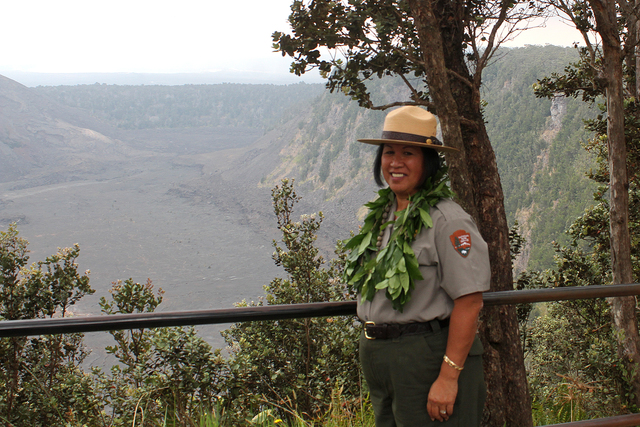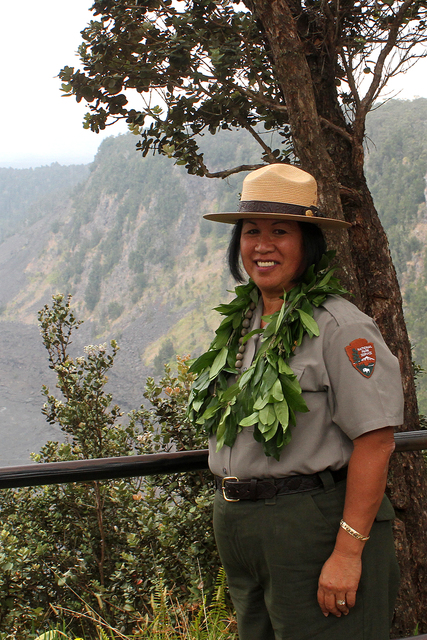The Kilauea Iki overlook is one of Joni Mae Makuakane-Jarrell’s favorite parts of Hawai‘i Volcanoes National Park: a place for little moments (sitting and eating lunch while occasionally spotting ‘io and koae kea soaring around the caldera) and big ones (getting married).
The Kilauea Iki overlook is one of Joni Mae Makuakane-Jarrell’s favorite parts of Hawai‘i Volcanoes National Park: a place for little moments (sitting and eating lunch while occasionally spotting ‘io and koae kea soaring around the caldera) and big ones (getting married).
She doesn’t eat lunch at the overlook as much anymore, though. For one thing, it used to be easier to access, before a 1983 earthquake heaved the main road into a path cars can no longer drive down. But she’s also kept busy by her job as chief of interpretation for the park: Makuakane-Jarrell is the first woman and first Native Hawaiian to have that position.
There are many faces to the park, but the ones seen most often by visitors are the rangers in the interpretation division. This is a role taken seriously by all: All rangers want you to love the park just as much as they do.
“They (the employees and volunteers) love this place. They really love protecting and providing the resources. They love providing superior customer service to our visitors,” Makuakane-Jarrell said.
Makuakane-Jarrell has been on the job for more than 35 years, but says you don’t need longevity to be enthusiastic and passionate about the park.
“It’s not really about the number of years,” she said.
Born and raised in Hilo, Makuakane-Jarrell started working at the park as part of the 1978 cohort of the Young Adult Conservation Corps program. She visited the park with her parents while growing up, and can still remember the roaring sounds of Kilauea Iki’s 1959 eruption.
Makuakane-Jarrell’s parents were from Puna and Ka‘u, the two districts that comprise the park.
“How would this happen for me, that I work at Hawai‘i Volcanoes, and I serve the … districts that my parents were from and the ohana was from?” she said. “Talk about loving where you are! It’s more important when your heart never leaves home and you can share the stories of your birth.”
The YACC, which pulled members of the community into the park to train for federal jobs, was the opportunity of a lifetime, and Makuakane-Jarrell has indeed spent her entire career in the parks service, from the USS Arizona Memorial to Kaloko-Honokohau and Pu‘uhonua o Honaunau National Historic parks.
“Every park is very unique in its own way,” she said. “But they all connect to a story of some kind.”
At HVNP, she’s been a supervisory ranger and educational outreach specialist. She’s seen the park ranger staff change from a largely male-dominated one to a much more representative one that better reflects Hawaii Island’s community.
That change was at least in part assisted by Makuakane-Jarrell herself — she helped kickstart the annual Cultural Festival and Na Leo Manu concerts, as well as the Ike Hana Noeau cultural workshops that introduce visitors and locals alike to kupuna and their craft.
“I think that’s why the traditional knowledge is so important, and for us to continue to weave culture and science together because Hawaiians know full well how to live in harmony on this land,” Makuakane-Jarrell said. “And this is the story that we can continue to share with our visitors, that cultural connection.”
The No. 1 reason people come to the park is not usually for that connection. People come expecting lava bursting from the earth. The reality of the park is more nuanced.
“When you tell them that they’re not able to see lava, they kind of have this look on their face of a little disappointment, a little frustrated,” Makuakane-Jarrell said. “But, you know, when you start sharing with them — oh my gosh, there’s so many other significant, magnificent, important things at this park.”
To see the present and the future, she’ll suggest going to the Jaggar Overlook, the edge of the volcano, where “you can literally see the breath of Pele coming out of it.” To see the past, she’ll suggest the lava tubes, weaving in the story of Aila Au, the male deity whose lava flows moved through the forest even before Pelehonuamea arrived.
It’s those kind of stories, the ones that dig deeper into the park than most visitors could imagine, that Makuakane-Jarrell cherishes. They connect the dots between then and now, between the land and the people who have lived there. They tell the full story.
Makuakane-Jarrell plans to retire in September.
“Starting and ending my career at Hawai‘i Volcanoes National Park … a part of me doesn’t want to go,” she said. But she’s looking forward to the new chapter, to focusing more on the traditional crafts — kapa making, lauhala making, lei making — she hasn’t had much time for while working and raising a family.
“There’s just so many things I want to do,” she said. There are places to visit and revisit, like Kiholo and Hakalau, and there are more stories to tell.
“I’d like to go back and do those things with my granddaughter, who’s 9 — pretty soon, 10,” Makuakane-Jarrell said. “I want her to be able to experience my childhood.”
“For me, that’s my way of honoring, preserving and perpetuating the Hawaiian culture,” she continued. “So I’m doing no different than what my grandmother did for me, what my mother did for me.”





